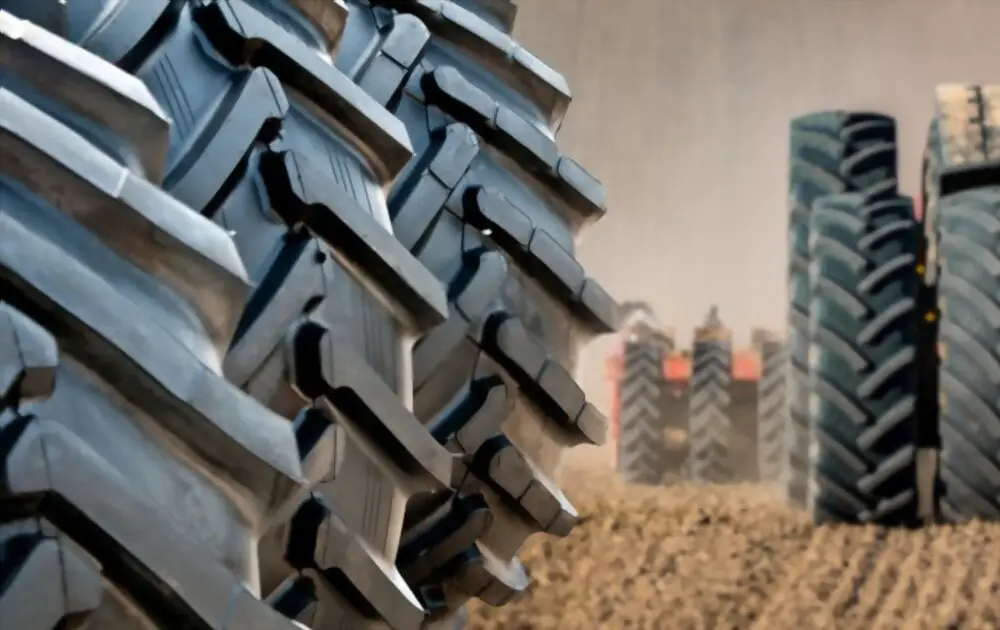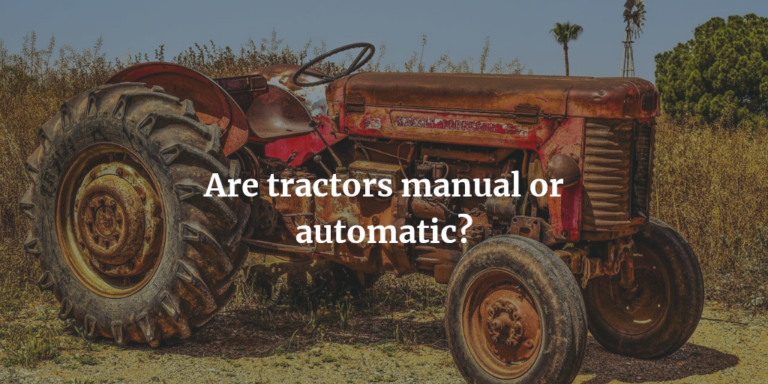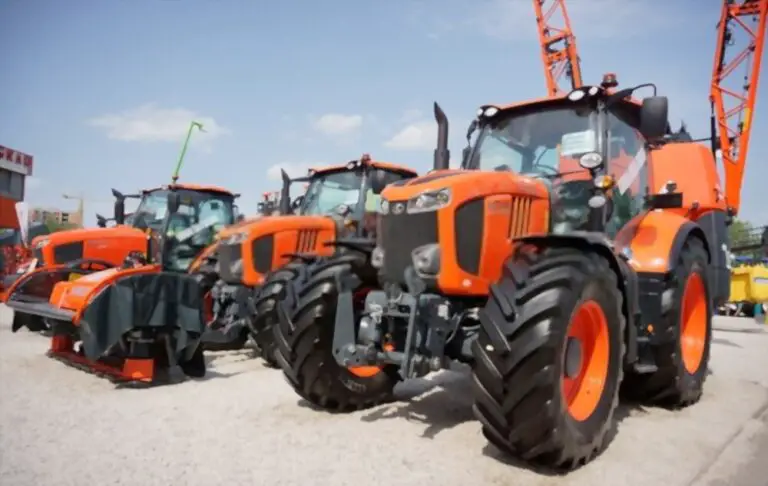Tires are one of the most important parts of your tractors. They play a big role in the daily usability and operation of tractors. Without them, your tractor will be useless. For this reason, it is highly essential you know about your tires.
Can tractor tires come tubeless? Can a tube-type tractor tire run tubeless? Can you put a tube in a tubeless tractor tire?
In the article, I will explain everything you need about the major tractor tire types: tube-type or tubeless.
About Tube Type Tractors
Tube-type tractors are tractors that have visible tubes on their tires. These tractors are more practical for riders who work on rough surfaces, off-roads, or surfaces that easily puncture the tires.
Advantages of Tube Type Tractor Tire
- They are easy to repair in a case where the tire puncture. If a tire punctures, you will pull out a new tube. Dismount the wheel, replace the tube, inflate the tire, and mount the wheel back.
- Tubes are relatively lightweight and compact, so they can be stored inside small or large bags.
- If your tires get damaged significantly, tubes can replace them, which can let you drive your tractor back to its parking slot, and
- The practical benefits of replacing tubes outweigh the novelty of owning tubeless tires.
What are Tubeless Type Tractor Tires?
A tubeless tire has a rubber liner within the tire. The liner is designed to reduce air leaks, especially in the rim of the tires. Tubeless tires are not impervious to harm.

Driving your tubeless tractor on a rough surface and accidentally running over a hard object will sustain serious damage.
However, these damages are less immediately apparent. This is because the liner prevents air pressure from decreasing rapidly, enabling you to safely drive back to your farm.
Advantages of Tubeless Type Tractor Tire
Currently, in our world, tires cannot escape being punctured. Many have argued that those tubeless type tractors are the best.
But is that so? Below are the advantages of choosing a tubeless type tractor.
- Excellent heat emission: The heat emission of a tubeless type is one major selling point of the tire. The rim of a tubeless tire is adjacent to the tire, enabling contact to occur. Such isn’t feasible with tubed tires.
- Better durability: Tubeless tires are more durable than tubed tires, such as binding cement within the tires so that the liner leaks air even more slowly. This increases the longevity of your tires.
- Not having to repair or maintain a tube as you do on tubed tires. Thereby saving expense.
- Better operational efficiency: Tubeless tires helps to reduce the time you spend outside your farming taking care of your tractor. Since there are no tubes, there is no need for extra care on the tractor. Thereby boosting the operational efficiency of the tractor.
- Safer tire choice: As discussed earlier, when your tires get punctured, the liner on the tubeless tire help to prevent the air from decreasing rapidly. This adds to safety and provides peace of mind while operating your tractor.
The advantages of tubeless tractors are many, you may say. Are there no disadvantages to it? Yes, they are. There is no machine part type without a disadvantage.
Disadvantages of Tubeless Type Tractor Tires
- Bad assembly can make tubeless tires seem inefficient: If the rim and tires are badly disassembled or arranged, it can reduce the capacity of the parts of the tires to work collectively to prevent air leakages.
- Tire beads can crack: A tire bead is part of the tire’s edge that goes on the wheel. If the tubeless tie is underinflated or overinflated, it may lead to a crack in the tire beads. When this happens, the tire liner will begin to separate, affecting your tractor’s efficiency.
Can you put a tube in a tubeless tractor tire?
A tubed tire cannot be used as a tubeless tire. The beads on the two types of tires are different so that the tube tire would not seal against the rim and cause damage to the tires.
As a result of their design and construction, a tubed tire cannot be used as a tubeless tire. Although, a tubeless typed tractor can run with a tubed tire.
All that is required is to change the beads and put a tube inside the tire. The only way for a tube-type tractor to run tubeless is by conversion. This takes us to the last point of the article.
Tube vs. Tubeless Tractor Tires: Differences

To better understand what Tube and Tubeless tractor tires mean, let’s look at how they differ.
1. Tire Interior
Tubed tractor tires have inner tubes within them that store pressurized air. While the tubeless tires are designed without inner tubes, this is the significant difference between them.
2. Ease of Repairs
When you return from the farm, you inspect your tractor, including the tires, to see whether everything is okay. In the case of damaged tires, a tubed tire may be completely flat out of deflation, but there should be some air if it is a tubeless tire.
Also, the tubeless tire will be easier to repair because it is easier to repair a semi-full tire than a flat one. In fixing a tubed tire, you repair the tire and the tubes.
3. Puncture Protection
What happens when the tire gets punctured varies from tube type to tubeless tire tractor.
Let’s take, for example, that you are driving your tractor, and you accidentally run off a nail that drives deep into your tire. If that nail touches the inner tube, your tractor tires are down completely. The only option remaining is to get a new one.
While, in a tubeless tire, it isn’t so. Although the tire will be affected, the liner will prevent the tire from going flat by helping to control the amount of air that leaves. You can even drive for some distance with punctured tires.
How to Convert a Tube Tractor Tire to a Tubeless Type
Converting a fully tubed type tractor tire to a tubeless one requires a bit of attention to detail and craftsmanship because sealing out any potential leaks areas will be the focus of the job.
Before you embark on the conversion, I advise buying reputable tubeless conversion kits. This kit is designed after vast research to aid you in the process and to make the process simpler.
However, if you want to know the steps that are involved in the conversion, here are they:
1. Preparation
To prepare your tractor for conversion, ensure your tire rim is perfectly aligned with the hub. This is necessary because spoke adjustment can break the air seals for a tubeless conversion.
2. Seal off the spoke nipples on the rim
The spoke nipples of the rim are the largest obstacle for tubeless conversion since this is where air leakages are prone to occur more.
To create a seal in the rims, dismount the tire and the tube and apply sealant on each of the spoke nipples suited on the outer part of the rim. This will create an air seal through which air cannot escape.
3. Create a secondary seal
After you have finished securing, each spoke nipple with an air seal; the next step is to create a secondary seal that spans the circumference of the rims. This is usually done using medium-width tape with a powerful adhesive that wraps around the rim to produce air seals.
While in the process, ensure that the tape isn’t wide enough to interfere with the mounting beads of the tire. Because if you don’t check and the tape is too wide, it can cause air leakage in the tire.
4. Purchase tubeless tires and mount
Once the rim is perfectly sealed off and an airtight seal is made on the rim, the next step is to purchase a tubeless tire to the type of your rim.
Ensure the tire you buy is the same size and dimension as your old one. After you have mounted the tire on the rim, the next step is to monitor the air pressure for a day or two.
If you didn’t notice any air leakages, that tells you that your work was done well, and you are good to go. I believe the above information has given you enlightenment on tractor tires as to whether it is being tubed or tubeless.






